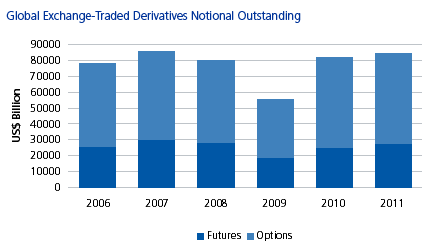Global Exchange-Traded Derivatives: A Silver Lining Amid Dark Clouds?
Abstract
The exchange-traded derivatives market has been one of the few highlights of the post-financial crisis period. This has been a result of innovative products such as exchange-traded fund options and volatility index derivatives in the developed markets of the US and Europe, along with the boom in equity, currency, and commodity derivatives in the emerging markets such as Brazil, India, and China.
In this report, Global Exchange-Traded Derivatives: A Silver Lining Amid Dark Clouds?, Celent looks at the development of the exchange-traded derivatives market after the financial crisis. Exchange-traded derivatives have seen healthy growth rates over the last few years. In terms of notional amount outstanding, futures grew by 14.95% between 2005 and 2010, with options growing by 14.67% over the same period. The markets have grown at similar rates, with futures market notionals having grown at a CAGR of 14.9%, and the options market notionals having a CAGR of 14.7% between 2006 and 2011.
This report discusses the changes expected under the new regulatory regimes in the leading global markets for OTC derivatives. The responses to the crisis have meant that there are widespread changes expected with regard to OTC derivatives in the US and Europe. Volumes will migrate from the OTC markets to their exchange-traded counterparts.

“The introduction of regulations such as the Dodd-Frank Act in the US and EMIR in Europe is expected to move some trading volumes from OTC derivatives markets to exchange-traded products due to factors such as cost and efficiency,” says Anshuman Jaswal, Celent Senior Analyst and author of the report. “According to our analysis, the derivative segments that will benefit most from these regulatory changes are commodity and currency derivatives, followed by long-term interest rate options and single stock derivatives.”
This report looks at regional and global volumes for derivatives products worldwide. It compares exchange-traded derivatives with OTC derivatives in terms of size and the cash equity market and in terms of growth rates of the leading exchanges over 2009–2010. This is followed by a section on the leading global exchanges. The impact of derivatives regulation is also reviewed, looking at various scenarios for the exchange-traded markets. The report also examines the expected growth (in volumes) of exchange-traded equities, commodities, interest rates, and currency derivatives, due to migration in volumes from OTC derivatives markets.

